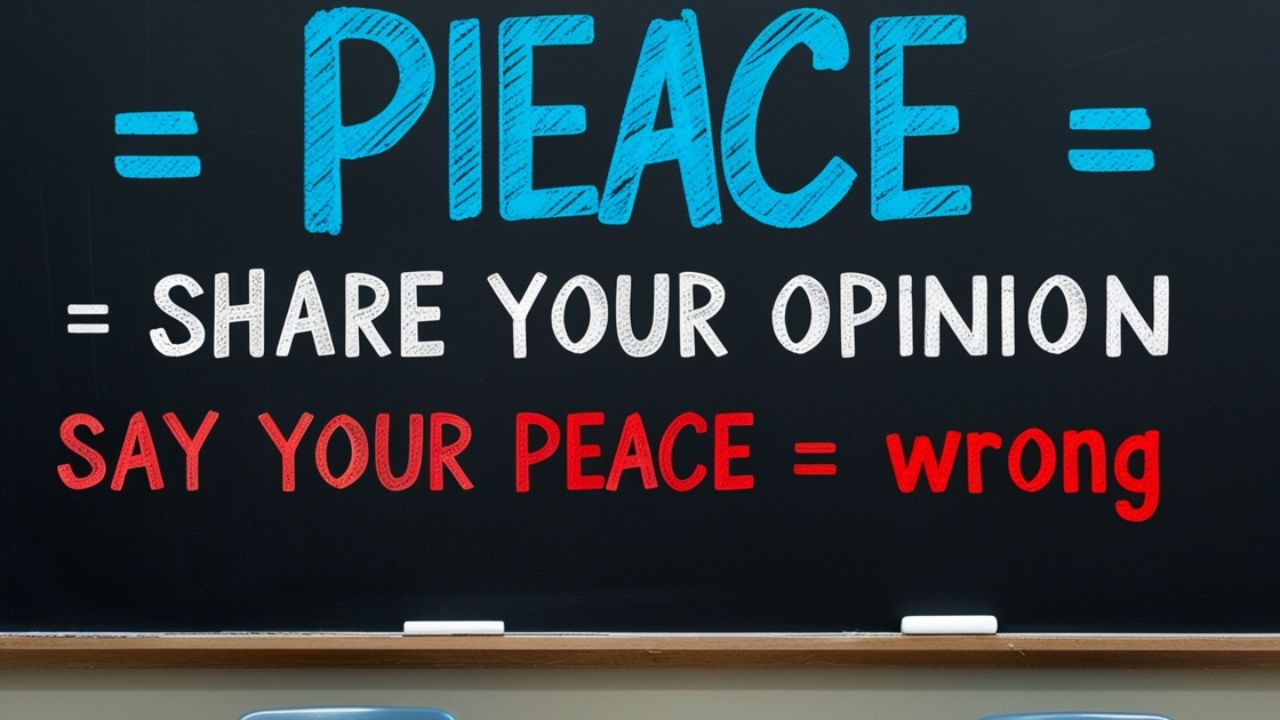The phrase say your piece is the right form. It means giving your part in a talk or discussion. The word “piece” shows that you are adding your share, like a puzzle piece that completes the picture.
The mix-up comes from the word peace, which sounds the same. Peace means calm, comfort, or silence, not sharing ideas. People often type it by mistake, especially in texting or when using voice tools that confuse the two words.
Using the correct form makes your speech clear. When you use say your piece, you show respect for language and for others listening. Good word choice makes you sound smart, careful, and easy to understand in every setting.
Commonly Confused Idioms: Why This One Stands Out
Many people mix up phrases because some words sound the same. The idiom say your piece often gets confused with say your peace. This happens because “piece” and “peace” sound alike, but they carry very different meanings in daily conversation.
Understanding the right phrase helps in clear speaking and writing. When you use say your piece, it means sharing your opinion. Using say your peace changes the meaning. Knowing the difference builds confidence and makes your words stronger.
Exploring the Correct Expression: Say Your Piece
The idiom say your piece means sharing your thoughts or ideas in a group. Long ago, people used it when speaking their part in a speech. Today, it still gives the same meaning of adding your voice to a talk.
When someone says say your piece, it shows a chance to speak freely and be heard. It is often used in meetings, debates, or even simple talks at home. The phrase reminds us that every opinion matters.
- The idiom say your piece means sharing your opinion or thoughts in a discussion.
- The word piece shows a part, like a piece of speech or prepared lines.
- It is often used when someone gets their turn to talk.
- The phrase gives permission to speak honestly without being interrupted.
- In meetings, debates, or family talks, say your piece supports fair and respectful communication.
The Incorrect Variant: When “Say Your Peace” Sneaks In

The phrase say your peace appears when people confuse similar-sounding words. It feels correct because peace means calm. But here, it does not match the real sense. The mistake happens often in online writing, chats, or quick notes.
Mix-ups like say your peace spread because tools like autocorrect or voice typing switch words. Many readers accept it without noticing. Still, this small change shifts the meaning and makes the sentence unclear in serious talks or written work.
- The phrase say your peace appears when people confuse it with the correct idiom because the words sound the same.
- Peace means calm or harmony, so using it here changes the meaning completely.
- Autocorrect, quick texting, or voice typing often spread this wrong form.
See also : Passerby vs Passersby: Correct Plural Explained
The Role of Homophones in Idiomatic Mix-Ups
| Correct Idiom | Common Error |
| for all intents and purposes | for all intensive purposes |
| toe the line | tow the line |
| breathe easily | breathe easily (often misheard) |
| wet your appetite | whet your appetite |
| fine-tooth comb | find-tooth bomb |
Words like piece and peace sound the same, so they are called homophones. Because of this, many people choose the wrong word when writing or speaking. This mix-up often changes the meaning and makes the message less clear.
Idioms become harder when homophones are involved because the ear hears no difference. Readers must depend on context to understand the right form. Learning these word pairs helps avoid mistakes and keeps communication smooth in both school and daily life.
- Homophones are words that sound the same but have different meanings, like piece and peace.
- These words often cause errors in idioms because the ear cannot tell them apart.
- Understanding context helps choose the correct word and avoid confusion.
Understanding Homophones: Why Context Matters
Words like piece and peace are called homophones because they sound the same but mean different things. You can find the right meaning by looking at the sentence. Context always helps in knowing which word should be used.
If someone says “say your piece,” it means share your opinion. But when you read “find peace,” it means calm or rest. Learning how homophones change meaning with context makes speaking and writing much clearer for everyone.
- Homophones need context to show their correct meaning in sentences.
- The word piece points to a share or part, while peace means calm or rest.
- Careful reading or listening makes it easier to pick the right word.
Contextual Clarification: Say Your Piece or Peace?
In a group talk, the phrase say your piece is correct because it means giving your share of ideas. The word “piece” fits the setting and shows that you are adding your own voice to the discussion.
When people use peace instead, it gives a different sense linked to calm or comfort. That meaning does not suit debates or meetings. Paying attention to the context helps choose the right word and keeps the message easy to follow.
Maintenance of “Piece” in the Modern Lexicon
The phrase say your piece is still used in books, classrooms, and daily talks. Teachers, leaders, and writers choose it to invite opinions. The word “piece” stays strong in language because it carries a clear meaning of sharing thoughts.
In workplaces and family talks, people use say your piece to give space for honest views. Even with new ways of speaking online, this form continues. It remains useful because it respects every person’s right to speak and be heard.
- The idiom say your piece is still common in schools, offices, and books.
- It encourages people to share opinions clearly during talks or debates.
- Despite new digital trends, the phrase continues to hold value in modern language.
Digital Age & Auto-Correction: Words on Thin Ice
- Autocorrect and voice tools often replace piece with peace, creating mistakes in writing.
- Quick texting habits spread these errors without people noticing.
- Careful checking of messages helps keep idioms correct and communication clear.
Why “Say Your Piece” Matters in 2025

In 2025, the phrase say your piece holds value because clear words build trust. People share ideas on social media, at work, and in school. Choosing the right idiom shows respect for language and improves how others understand you.
Using say your piece in talks or writing also protects your voice from being misunderstood. Correct phrases help leaders, students, and workers speak with confidence. Strong language choices remain important in a world that moves fast and demands clarity.
- Using say your piece shows clear thinking and respect for proper language.
- Correct idioms build trust in schools, workplaces, and online talks.
- In fast communication, accuracy helps voices stand out and prevents confusion.
Tips for Getting It Right
To use say your piece correctly, think of it like a small part of a puzzle. Your words are one piece that fits into a bigger picture. This simple link helps remember which word matches the idiom.
Another way is to practice sentences with say your piece during reading or speaking. Picture giving your turn in a class or meeting. The phrase then becomes natural, and it helps you avoid mixing it with the wrong word.
- Link say your piece to a puzzle piece, showing your part in a talk.
- Practice sentences using the idiom to remember the correct form.
- Always review your writing to avoid confusing it with the word peace.
See also : Cart vs Kart: Key Differences Explained Simply
Final Thoughts
The idiom say your piece reminds us that small details in language matter. Choosing the right words makes speaking clear and respectful. It also helps others understand your ideas without confusion, whether in class, at work, or in daily life.
Correct phrases like say your piece also protect your message from being misunderstood. Clear language builds trust and shows care for communication. When you practice and remember simple rules, your words become stronger, and your thoughts shine with confidence.
FAQs
When to use peace or piece?
Use peace for calm or harmony and piece for a part of something. Context decides which word fits the sentence correctly.
Is it correct to say “at peace”?
Yes, at peace is correct. It means being calm, free from worry, or feeling restful in mind and body.
What is the meaning of your peace?
Your peace means your personal calm, comfort, or sense of harmony. It often refers to inner balance or emotional rest.
Is it hold your piece or hold your peace?
The correct phrase is hold your peace, meaning stay silent. Hold your piece is wrong and does not fit the idiom.

Join Bibcia on a journey to master English grammar. Discover easy lessons, writing tips, and practical examples designed to make learning grammar simple and effective.










